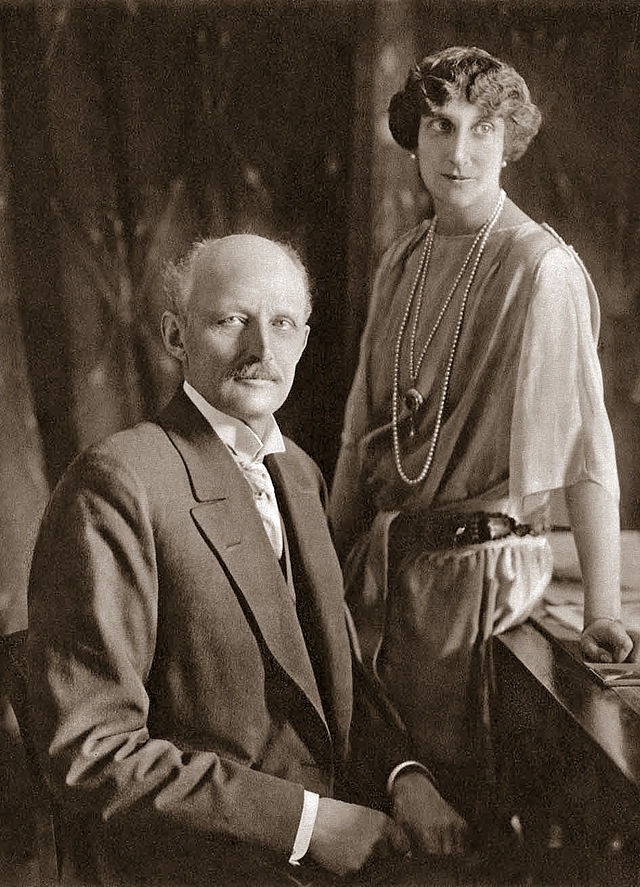by Emily McMahon and Susan Flantzer © Unofficial Royalty 2013

Prince Carl of Sweden; Credit – Wikipedia
Oscar Carl Wilhelm, called Prince Carl, was born at Arvfurstens Palace in Stockholm, Sweden on February 27, 1861. He was the third of four sons of King Oscar II of Sweden and Sophia of Nassau. Like his father, Carl exhibited excellent skills of diplomacy and was later sought to help mediate peace talks and arrange the release of political prisoners. Carl had three brothers:
- King Gustaf V of Sweden (1858-1950) – married Victoria of Baden, had issue
- Prince Oscar, Duke of Gotland (1859-1953) – later Count Bernadotte af Wisborg, married Ebba Munck af Fulkila, had issue
- Prince Eugén, Duke of Närke (1865-1947) – unmarried

Princess Ingeborg of Denmark and Prince Carl of Sweden in 1897; Credit – Wikipedia
In May 1897, an engagement was announced between Carl and another Scandinavian royal, Princess Ingeborg of Denmark. Born at Charlottenlund Palace in Copenhagen, Denmark on August 2, 1878, Ingeborg was the second daughter and fifth child of the future King Frederik VIII of Denmark and his wife Lovisa of Sweden. Although neither was the heir to a throne, the prospect of another Danish-Swedish royal union was exciting to the families of the couple and citizens of their respective countries. On their 50th wedding anniversary, Carl admitted that their marriage had been completely arranged by the couple’s fathers. Ingeborg added, “I married a complete stranger!”
The wedding was held at Christiansborg Palace Chapel in Copenhagen, Denmark on August 27, 1897. Among the guests were Alexandra, Princess of Wales and Russian Dowager Empress Maria Feodorovna (Dagmar of Denmark), the bride’s aunts. Copenhagen was decorated with flowers and flags of both countries to celebrate the occasion. Following a brief stay in Denmark, the new couple set off for a honeymoon in Germany.
Carl and Ingeborg had a comfortable family life, dividing their time between Arvfurstens Palace in Stockholm and summers in Fridhem, Sweden. Despite the difference in their ages (Carl was 17 years older than Ingeborg), the two were happy and well-suited to one another. The couple had four children born between 1899 and 1911. They were:
- Princess Margaretha of Sweden (1899–1977), married her cousin Prince Axel of Denmark, had two sons
- Princess Märtha of Sweden (1901–1954), married her cousin King Olav V of Norway, had two daughters and one son
- Princess Astrid of Sweden (1905–1935), married King Leopold III of Belgium, had two sons and one daughter
- Prince Carl Bernadotte, born Prince Carl, Duke of Östergötland (1911–2003), married (1) Countess Elsa von Rosen, morganatic marriage – had to relinquish his succession rights and his royal titles, had one daughter, divorced (2) Ann Margareta Larsson, no children, divorced (3) Kristine Rivelsrud, no children
During their young adulthood, the four children of Ingeborg and Carl were repeatedly sought after as spouses by several European monarchs. Astrid and Märtha were both linked to the future King Edward VIII of the United Kingdom before their respective marriages. Queen Wilhelmina of the Netherlands strongly desired a marriage between Carl and her daughter and heir, the future Queen Juliana of the Netherlands. However, the two vehemently disliked each other upon meeting in the late 1920s. Carl and Ingeborg are ancestors of the current Belgian royal family, Luxembourg grand ducal family, and Norwegian royal family. Belgian Kings Baudouin and Albert II, Norwegian King Harald V, and Grand Duchess Josephine-Charlotte of Luxembourg, the wife of Grand Duke Jean of Luxembourg, are all grandchildren of Carl and Ingeborg.
Carl and Ingeborg continued to play important roles in European history throughout their marriage. Ingeborg served as the de facto first lady of Sweden for several years during the absence of Sophia of Nassau and Viktoria of Baden. Due to her close familial connections, she also worked to bring peace to the three Scandinavian royal families following the Norwegian independence in 1905. Carl distinguished himself as the President of the Swedish Red Cross, earning several Nobel Peace Prize nominations for his work with prisoners of war.
Both Carl and Ingeborg lived long lives. Carl died on October 24, 1951, in Stockholm, Sweden at the age of 90. Ingeborg survived him by seven years, dying in 1958 at age 79. The two are buried in the Royal Burial Ground in Haga Park in Solna, Stockholm, Sweden.

Prince Carl and Princess Ingeborg in 1926; Credit – Wikipedia
This article is the intellectual property of Unofficial Royalty and is NOT TO BE COPIED, EDITED, OR POSTED IN ANY FORM ON ANOTHER WEBSITE under any circumstances. It is permissible to use a link that directs to Unofficial Royalty.
